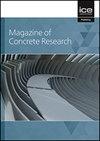Experimental study on static and impact properties of concrete incorporating nano-SiO2, nano-Al2O3 and Fe2O3 in single and combined forms
IF 1.8
4区 工程技术
Q3 CONSTRUCTION & BUILDING TECHNOLOGY
引用次数: 0
Abstract
This paper presents a comparative evaluation of the single and combined effect of nanoparticles on the static and impact properties of concrete. Nano-SiO2, nano-Al2O3 and nano-Fe2O3 were used separately and in combined forms as partial replacements of cement by 1% and 2% by weight. The impact of nanoparticles on the unit weight, compressive strength, split tensile strength, flexural strength, toughness, fracture energy, impact performance of concrete was experimentally examined. In addition, the effect of these nanoparticles on the microstructure of concrete was investigated using SEM analysis. Moreover, to evaluate the commercial production of such concretes, the cost effectiveness of use of nanoparticles in concrete was also discussed. Desirability function analysis was also conducted to compare the overall performance of the tested concretes. The results revealed that use of nano materials in concrete had a positive effect on improving their mechanical performance. Nanoparticles increased the compressive strength, split tensile strength, flexural strength, and energy absorption capacity of concrete. Use of nanoparticles didn't show any significant influence on the unit weight of concrete. Moreover, the results also showed that nano materials didn't have a good influence on the impact performance of concrete. SEM analysis showed that use of nanoparticles improved the microstructure of concrete.关于掺入纳米二氧化硅、纳米氧化铝和纳米氧化铁的单一和组合混凝土静态和冲击性能的实验研究
本文比较评估了纳米颗粒对混凝土静态和冲击性能的单一和综合影响。纳米二氧化硅、纳米 Al2O3 和纳米 Fe2O3 分别以 1%和 2%的重量百分比被用作水泥的部分替代品。实验检验了纳米颗粒对混凝土单位重量、抗压强度、劈裂拉伸强度、抗折强度、韧性、断裂能和冲击性能的影响。此外,还利用扫描电镜分析法研究了这些纳米颗粒对混凝土微观结构的影响。此外,为了评估此类混凝土的商业生产,还讨论了在混凝土中使用纳米颗粒的成本效益。还进行了可取性功能分析,以比较测试混凝土的整体性能。结果显示,在混凝土中使用纳米材料对提高其机械性能有积极作用。纳米颗粒提高了混凝土的抗压强度、劈裂拉伸强度、抗弯强度和能量吸收能力。纳米颗粒的使用对混凝土的单位重量没有明显影响。此外,研究结果还表明,纳米材料对混凝土的抗冲击性能也没有很好的影响。扫描电镜分析表明,纳米颗粒的使用改善了混凝土的微观结构。
本文章由计算机程序翻译,如有差异,请以英文原文为准。
求助全文
约1分钟内获得全文
求助全文
来源期刊

Magazine of Concrete Research
工程技术-材料科学:综合
CiteScore
4.60
自引率
11.10%
发文量
102
审稿时长
5 months
期刊介绍:
For concrete and other cementitious derivatives to be developed further, we need to understand the use of alternative hydraulically active materials used in combination with plain Portland Cement, sustainability and durability issues. Both fundamental and best practice issues need to be addressed.
Magazine of Concrete Research covers every aspect of concrete manufacture and behaviour from performance and evaluation of constituent materials to mix design, testing, durability, structural analysis and composite construction.
 求助内容:
求助内容: 应助结果提醒方式:
应助结果提醒方式:


